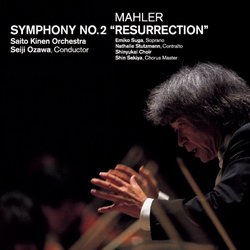| All Artists: Gustav Mahler, Seiji Ozawa, Nathalie Stutzmann, Emiko Suga, Saito Kinen Orchestra, Sinyukai Choir Title: Mahler: Symphony No. 2 "Resurrection" Members Wishing: 0 Total Copies: 0 Label: Sony Release Date: 12/19/2000 Genre: Classical Style: Symphonies Number of Discs: 2 SwapaCD Credits: 2 UPC: 696998937420 |
Search - Gustav Mahler, Seiji Ozawa, Nathalie Stutzmann :: Mahler: Symphony No. 2 "Resurrection"
 | Gustav Mahler, Seiji Ozawa, Nathalie Stutzmann Mahler: Symphony No. 2 "Resurrection" Genre: Classical
The Saito Kinen Orchestra was created in 1984 for a series of concerts honoring the memory of Hideo Saito, Japan's most influential music educator and founder of the Tokyo Music Academy that bears his name. One of its firs... more » |
Larger Image |
CD DetailsSynopsis
Amazon.com The Saito Kinen Orchestra was created in 1984 for a series of concerts honoring the memory of Hideo Saito, Japan's most influential music educator and founder of the Tokyo Music Academy that bears his name. One of its first and most famous graduates was Seiji Ozawa, who cofounded the orchestra and under whose leadership it performs worldwide. This record was taped live in Tokyo during special millennium concerts in 2000. Many of Saito's former students who now hold prominent positions in the West participated; the personnel list in the booklet contains numerous names familiar to American audiences, notably cellist Sadao Harada, founding member of the Tokyo String Quartet, and violinist Hiroko Yajima of the Mannes Trio. Perhaps because it was taped in performance, the recording is not of optimal technical quality. Dynamic contrasts are excessive, from almost inaudible pianissimos to ear-splitting explosions of sound, necessitating an alert finger on the volume control, and the tone is sometimes harsh and shrill. The playing is good, with some beautiful solos from the concertmaster and the winds, but it's a little stiff, inflexible, and inhibited. The musicians do not seem entirely comfortable with Mahler's abrupt changes of tempo and mood, his unfettered flights into the depths and heights of emotion, his sardonic irony, his characteristic march and waltz rhythms. However, in the last movement, the power, mystery, and ecstasy of the music, as well as the concentrated expressiveness of the excellent chorus, combine to break down their restraint. Nathalie Stutzman has a lovely voice, but she sings with too much fussy intensity; Emiko Suga sounds pure, innocent, and angelic. --Edith Eisler Similar CDs
Similarly Requested CDs
|
CD ReviewsMahler's Debt to Beethoven Dr. Christopher Coleman | HONG KONG | 02/06/2001 (4 out of 5 stars) "The Saito Kinen Orchestra was founded in 1984 by Seiji Ozawa and colleagues in memory of Ozawa`s mentor and one of the most influential of Japanese music educators, Hideo Saito. It is a wonderful ensemble which proves that Asians can be totally at home with western music. The personnel of the orchestra are listed in the booklet, a practice that I wish more companies would follow. They do a superb job with Mahler's extremes of dynamics and dramatic tempo changes, and the result is a terrific rendition of this powerfully evocative music. That the Japanese, who so love Beethoven that mass performances of his Ode to Joy are commonplace, are now performing Mahler so wonderfully is completely appropriate.In this work, Mahler's debt to Beethoven is quite clear. Of course, Mahler's Second is a choral symphony following Beethoven's lead with his 9th. Mahler's funeral march in this piece is not only in the same key as the funeral march in Beethoven's Third Symphony, the Eroica, but there are similarities in the initial melodies as well. Mahler expands the number of movements in this symphony (as in others) to five, as Beethoven did in his 6th Symphony. Beethoven expanded the classical orchestra with the addition of trombones, piccolo, and contrabassoon in his 5th Symphony to heighten the expressive quality of the music, and Mahler often expands the romantic orchestra for similar purposes. But most important is Beethoven's structural thinking which Mahler inherited. Beethoven so expands the traditional sonata-allegro form that just the first movement of his Eroica Symphony is as long or longer as a whole symphony by one of his predescessors. Mahler took this expansion to heart, and makes each of his symphonies an entire musical world.Mahler's Second is often called the Resurrection Symphony, for the text of the final movement is a statement of faith in the afterlife. This text is based on an ode by Friedrich Klopstock, but Mahler himself made revisions and additions which make description of the journey of the soul to God more explicit. Mahler at one point created a program for the symphony which divided the work into sections such as "the last trump" and "the caller in the desert", but he later withdrew it as too much of a crutch for the audience. But these programatic details remain in the music--I think that one cannot listen to the passage that precedes the choir's first entrance in the final movement without an awareness that it represents the call to the final judgement, and that the flute is a musical portrayal of the holy spirit. This piece is full of some of the most extraordinary music ever written, and the Saito Kinen Orchestra does a wonderful job with it. This is a beautifully recorded live performance, and I think the criticism in the editorial review above that the dynamic contrasts are too extreme is absurd. Mahler wrote these extreme dynamics and he meant them, and while they may make the music unsuitable for performance as background music, or to play on a car stereo or boombox, without them the soul of the music is lost. I think the dynamic contrasts are superbly done, and absolutely necessary to an understanding of and emotional reaction to the work--if you don't like them, get a compressor. My only minor criticism is that at the very end, the brass seems to let down a bit of the intensity. Whether this is due to fatigue (which can be significant in this work, as it is very demanding on the brass) or simply a desire to bring out the choir, I am not sure. But I can highly recommend this performance in spite of this minor flaw." Simply the best Dr. Christopher Coleman | 12/03/2002 (5 out of 5 stars) "Ozawa of late, has been hampered by a bored Boston Symphony Orchestra, full of uninteresting repretoire and undesignated prinicpal section appointments. One wonders what happened to that dynamic Karajan protege of the 70's who inspired and charmed musicans to play their very best (the BSO certain do not under his current direction- 29 years is a long time)Two answers: That impish Ozawa has been doing his best work of late in Vienna (where the Austrians seem quite happy with his leadership) and of course with his Saito Kinen Orchestra. Simply put, this performance blew me away. Although I steadfastly subscribe to that crusty Klemperer version on EMI, Ozawa offers such a dyanmic, taut and dramatic performance that it can be included as one of the great Ressurections. The contralto is not Christa Ludwig, and she is a bit mannered for my tatse, but I cannot erase the first movement from my mind. Ozawa navigates this Brucknerian nightmare with such clarity , compassion and drama that I can no longer listen to the Klemperer disc because of the sloppy, plodding and unclear playing the Philharmonia engages in.Mind you, I am familar with the Klemperer, Abbado Chicago&Vienna, Metha, Bernstein-Vienna, Solti, Tennstedt, and Inbal versions of this work. None of them offer the concentrated committment of an orchestra playing, and surpassing the very edge of their powers.Give the first movement 15 mintues and you will be convinced." One of the very fine recordings of this symphony J. F. Laurson | Washington, DC United States | 12/20/2008 (5 out of 5 stars) "[Opinions naturally differ when it comes to Mahler... whose music tickles a different bone in every listener (assuming it tickles anything, at all). But this superbly played version of the Resurrection Symphony really should not be one of those divisive interpretations.]
White-hot intensity is achieved by - it may come as a surprise to those who know him as a purveyor of polished, `politically correct' rather than emotionally drenched, Mahler - Seji Ozawa. Not from his Boston Cycle (none of which is currently available in the U.S., anyway - a shame in the case of the Second, Fifth and Eighth) but from a concert with his Japanese Saito Kinen Orchestra. (The orchestra's first clarinet, by the way, is Karl Leister.) Emiko Suga (soprano) and Nathalie Stutzmann (alto), his soloists, are good if not necessarily outstanding; the choir is extraordinarily precise. But it is the orchestra and the conducting that really shine: These players seem to understand exactly what Ozawa wants - and what seems at first a very relaxed and loose performance, unnoticeably, surreptitiously ratchets its way up to an emotional force second to none. Ozawa vacillates between calm beauty and searing, roaring moments. His second movement has a gentle flow to it that exudes peace and Gemütlichkeit... very apt for a movement with the instructions "Sehr gemächlich. Nie eilen" ("Very gingerly paced. Never rushed"). His Urlicht emerges from the depths like it should. Even where the entire last movement does not quite soar as with Boulez, the finale is riveting." |

 Track Listings (2) - Disc #1
Track Listings (2) - Disc #1




